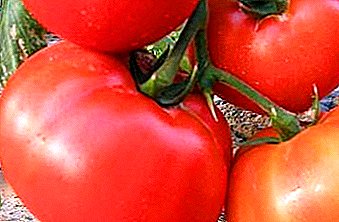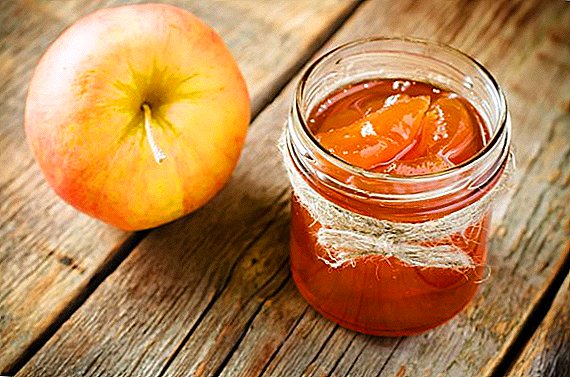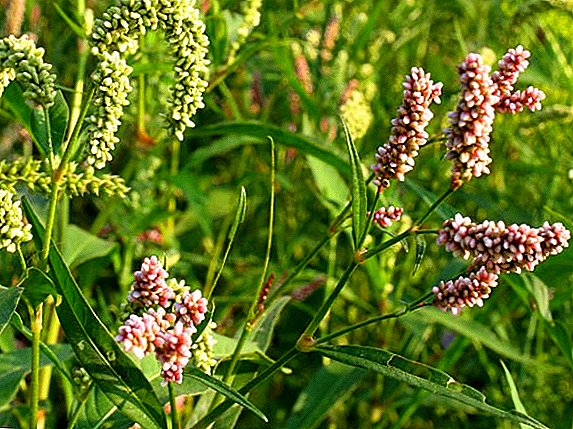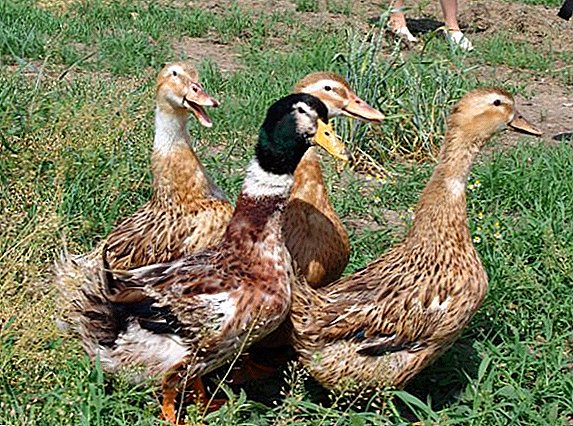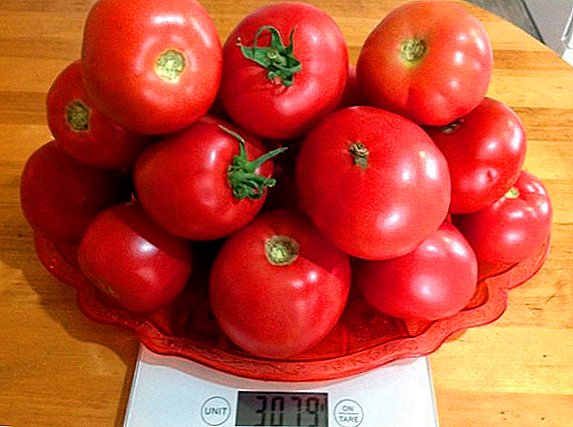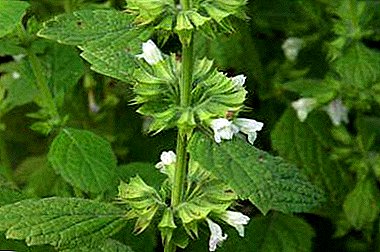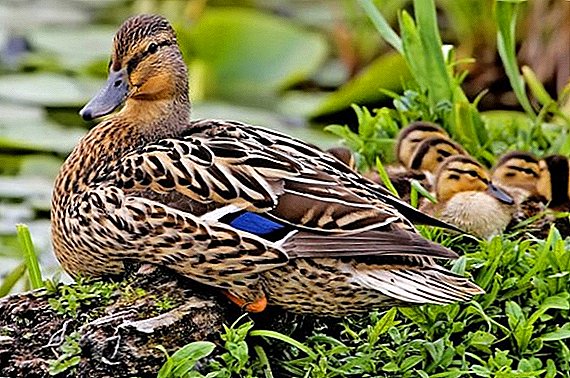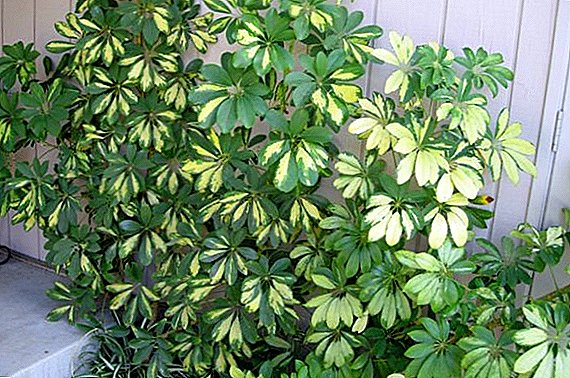 This peculiar plant is a frequent guest in many homes and offices.
This peculiar plant is a frequent guest in many homes and offices.
Beautiful, unpretentious sheflera - "a flower without flowers": care for her at home and the basis of cultivation - that is the theme of our story today.
Conditions
Sheflera is valued for its decorative look. Although it does not bloom, but its umbrella leaves, divided into several parts, serve as a good decoration of any place. And by her unpretentiousness she conquers many newcomers. 
Temperature
Sheflera has its origin from the warm edges - it is found in Africa, South America, but at the same time, this plant does not like high temperatures. The best for it is the usual room temperature of 20-22 ° C.
If the temperature is higher or will fluctuate strongly and often, the chefler will not like it and she will shed the leaves.
Did you know? In ancient times, wood cheflers used for making fire by friction.
In winter, the flower has a period of rest, and for complete rest, the temperature at the place of growth of the cheflers should be no higher than 18 ° C.
Better yet, keep it at 14-15 ° C, otherwise it will continue to grow, and there will not be enough light for it, and the leaves with shoots will come out frail and abnormal. Therefore, either hide the plant in a cool place, or keep it warm, but provide additional lighting. 
Lighting
The need for light for each type of cheflers is different.
As with a chefler, prickly pears, xantosomes, spurgeons, dieffenbachia, room ferns, date palms, miltoniopsis, ficus, aphelandra are ideal for home and office.Variegated - love a lot of light. Deprived of his drawing on the leaves pales and becomes not so beautiful. Therefore, this type of chefler can be placed on window sills, where there is a lot of sun.
But green leafy chefs feel good with a little shading.
Important! Any kind of chefler is contraindicated in direct sunlight for a long time.
The best location option will be windowsills on the east and west sides of buildings. 
Care
Shefflera will not cause much difficulty in how to care for her. Proper care is watering, periodically feeding and pruning.
Watering
Watering chefleru necessary often, but moderately. It does not tolerate either drought or overflow, for the land can sour. Focus on the condition of the top layer of soil - water if it is dry. In the summer they water 1 time in 2 days, in the winter - a little less.
Water should be clean, soft and warm. The difference in temperature between water and ambient air should be minimal.
In addition to watering the plant responds well to spraying. She needs high humidity. In the summer it is recommended to spray once or twice a day. In winter, during the period of heating and dry air, spraying is carried out more often.  Periodically you need to wipe the leaves with a damp sponge or arrange “douche” to wash off the dust.
Periodically you need to wipe the leaves with a damp sponge or arrange “douche” to wash off the dust.
Water for spraying should be the same as for irrigation - warm, soft and separated.
Cropping and crown formation
Periodically, the flower must be cut. This is done to rejuvenate the plant and return it to the aesthetic appearance.
At this time, all the shoots and leaves are cut off. Leave only a small part of the central stem. He is actively watering, and soon he will give new shoots and form a new plant.
Did you know? Sheffler got its name in honor of the botanist Jacob Scheffler, friend of Carl Linnaeus.
Scheffler is actively growing up, and to form the crown, the top must be periodically cut. Thus, growth is stimulated to the side. The frequency and size of trimming are determined individually.  Sometimes it can be quite significant, and sometimes just enough pinching.
Sometimes it can be quite significant, and sometimes just enough pinching.
Fertilizer
Feed the plant must be regularly. In the summer, fertilizing is carried out 2-3 times a month. During the rest period - every 1.5-2 months.
For fertilizers use complex mineral fertilizers (for example, "Florovit", "Master Agro" or other complex for indoor plants) and organic.
After fertilizer application, it is advisable to sprinkle the ground in a pot of crushed eggshell.
Transfer
Over time, the capacity in which the flower grows, becomes small, and you need to think about how to transplant the chef. Every 2 years, the plant should be transplanted into a larger pot.
The best time for this procedure is the end of the rest period until the beginning of the growing season, approximately in April.  Into the new pot pour the prepared drainage (crushed stone, stones), on it - the prepared earthen mixture. This mixture should be light, loose, slightly acidic.
Into the new pot pour the prepared drainage (crushed stone, stones), on it - the prepared earthen mixture. This mixture should be light, loose, slightly acidic.
The mixture can be prepared by yourself: you need 3 parts of compost, 1 part of peat, 2 parts of sand. And you can use the finished soil for indoor plants.
The plant with the whole earthen clod is carefully placed in a new pot, the new earth is filled to the necessary level and tamped a little. After that, water.
Rest period
In late autumn and until spring, the chefler lasts a period of rest. At this time, it is placed in a cool room. The temperature is preferably maintained at 16-18 ° C.
During this period, frequent watering and feeding are not required. Control the condition of the top word of the soil and water the plant when it dries. It would be nice to provide the plant with additional light sources. 
Fight against diseases and pests
An unpleasant attack in the form of a disease or harmful parasites can happen to the sheflera with improper care. In this case, the plant can hit aphid, shield or thrips.
It is in the wrong care that the answer to the question lies: why do leaves fall on the cheflers?
The best prevention is to follow the rules of plant care and regular inspection. Check the leaves for insects, and at the first sign of their appearance - rinse with a sponge dipped in soapy water.
But if, nevertheless, uninvited guests appeared - spray the flower with a solution of "Karbofos" or "Aktar".
Important! The chemical solution should not get into the soil.
If necessary, repeat the treatment after a week or two.  Sometimes the chefler turns yellow and sheds leaves. Most likely, you perederzhali plant under the sun. Move it deep into the room for a while, and the leaves will return to normal again.
Sometimes the chefler turns yellow and sheds leaves. Most likely, you perederzhali plant under the sun. Move it deep into the room for a while, and the leaves will return to normal again.
Also, a chef can shed leaves when the temperature is disturbed and the air humidity is not enough, or if the roots have begun to rot from excessive watering.
Follow the rules of care - and your green pet will not be sick.
Sheflera fully survives in any home, and ease of care and simplicity of this extremely contribute. Provide her with proper care, timely watering, and her umbrella leaves will delight your eyes for a long time.


